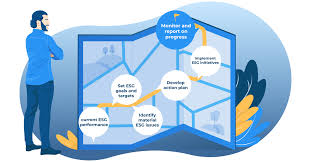Business
Explained: How To Implement ESG Strategies In Your Business

In today’s progressive corporate and business environment, ESG—the acronym for Environmental, Social, and Governance—is vital for businesses. Organisations contend with the mix of profit, aims, and well-being, so incorporating ESG strategies becomes a key compass. But what are ESG methodologies? It is a commitment towards sustainable growth. In addition to syncing businesses with societal values, enacting ESG strategies boosts financial performance, stakeholder reliability and financial performance. However, learning about these strategies before implementing them is a must. You can enrol in an ESG course and familiarise yourself with the strategies.
The article will dig into the complexities of implementing ESG strategies in your organisation. So, let’s explore the world of ESG courses strategies!
Steps to Develop and Implement ESG Strategies
Equip yourself and your employees with an in-depth understanding of the strategies by enrolling and getting certified in an ESG course. Below are the ways to implement ESG strategies:-
● Conduct an Efficient Assessment
Start by establishing time-bound, practical, and relevant ESG objectives. Precisely outlining your goals, why, and what you are doing will assist you in interacting with your consumers, collaborators, and employees about your organisation’s commitment to sustainability.
● Perform an Applicability Assessment
Next, an internal and external stakeholders applicability assessment will be performed to include their views on ESG course subjects and then summarise them in the materiality evaluation. Though explaining environmental, social, and governance topics to your enterprise’s stakeholders can be tricky, their insights facilitate prioritisation.
It is advisable to amalgamate effect screening with materiality evaluation to narrow down threats caused by ESG and the opportunities that have the biggest effect on your business.
● Consider Where You Are as a Beginning Point
When you decide on your topmost environmental, social, and governance priorities, it is time to check your company’s latest programs, policies, and interactions. To do this, you can associate with your company’s stakeholders, who are knowledgeable about all ESG concerns. It is advisable to begin with reports, policies, and data systems for general details and then move ahead with interviews with internal stakeholders for detailed understanding. The outcome of this assessment will provide you with a sense of developing and implementing ESG strategies. You can also learn about your competitors’ ESG maturity, the issues, and the opportunities and leading practices in your industry by involving peer benchmarking in your business.
● Set Clear Goals
After establishing an environmental, social, and governance starting point, you can plan where to focus the most. It is advisable to have working sessions with primary stakeholders on various topics to develop a clear vision for your environmental, social, and governance performance goals.
● Create a Long-term ESG Plan
After setting clear goals, it is time to monitor your progress towards achieving them. You can do this with the help of environmental, social, and governance performance structures. Many companies use these frameworks to standardise and disclose insights. There are many such structures you can select from, but the Global Reporting Initiative framework is one of the most famous ones. The others are as follows:-
- Carbon Disclosure Project (CDP) Reporting
- Climate Disclosure Standards Board (CDSB)
- Sustainability Accounting Standards Board (SASB)
- Science Based Targets Initiative (SBTi)
● Create an Action Plan
Environmental, social, and governance must be incorporated into your business practices and processes to function properly. It is advisable to plan various ways to stay in proper shape throughout the year so that you are already prepared when environmental, social, and governance are highlighted. Although keeping an eye on ESG course is beneficial, remembering that the vital change occurs on the ground is vital. Your team will require informative tips and instructions to get the desired outcome as you motivate your team to implement them and be accountable.
● Create a Status Report
ESG reporting is a complex procedure that involves setting goals. Regardless of your standards and guidelines, the most significant portion of reporting is to make your business information clear and concise to the public. But before you create a status report, it is advisable to decide what you wish to do with it.
● Wrapping Up
Even though the advancement and implementation of ESG strategies in your business may take time and precise planning, it offers privileges in multiple areas of your organisation. An ESG course helps understand these properly. Besides benefiting the environment by ensuring that your corporation has plans to become sustainable, ESG methodologies boost your standing in front of your employers, investors, and customers. As you cruise through the intricacies of a quickly changing world, ESG methodologies are the keys to accountable leadership.
From decreasing threats and drawing the attention of conscious investors to nurturing creativity and talent, ESG encourages businesses to make a positive difference beyond finances. Therefore, whether you are an experienced professional or an aspiring and budding business owner, do an online ESG course to shape a resilient future.
-
Blog1 year ago
MyCSULB: Login to CSULB Student and Employee Portal – MyCSULB 2023
-
Android App3 years ago
Cqatest App What is It
-
Android1 year ago
What Is content://com.android.browser.home/ All About in 2023? Set Up content com android browser home
-
Software2 years ago
A Guide For Better Cybersecurity & Data Protection For Your Devices
-
Latest News2 years ago
Soap2day Similar Sites And Alternatives To Watch Free Movies
-
Android2 years ago
What is OMACP And How To Remove It? Easy Guide OMACP 2022
-
Android3 years ago
What is org.codeaurora.snapcam?
-
Business2 years ago
Know Your Business (KYB) Process – Critical Component For Partnerships





















